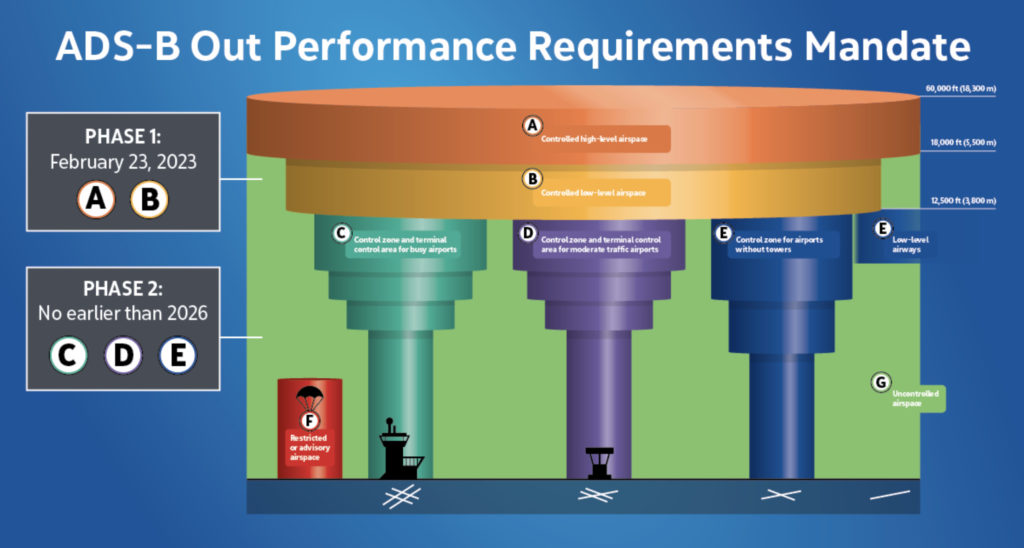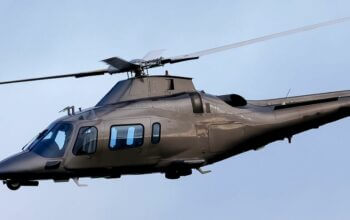Estimated reading time 8 minutes, 36 seconds.
The federal government and Nav Canada are determined to bring space-based Automatic Dependent Surveillance-Broadcast (ADS-B) Out technology to Canadian aviation. However, even though the industry has had several years to adjust to the concept, which is already used in some Canadian-controlled airspace, there is strong pushback from the key users of that airspace.
Transport Canada (TC) has said that it supports the ADS-B mandate for all aircraft operating at a flight level of 12,500 feet (8,300 meters) or higher, in Class A and B airspace, starting in February 2023. But TC has yet to announce the mandate.
Simply put, ADS-B calculates aircraft location, speed, and direction from the Global Navigation Satellite System (GNSS) and pumps the data 120 times a minute to air navigation services such as Nav Canada.

The mandate would bring all of Canada into line with an increasing international adoption of ADS-B surveillance technology. It’s already used over Hudson Bay, the very busy North Atlantic, and in domestic airspace above 29,000 ft (8,839 m). In what is being considered a proof-of-concept exercise, Nav Canada has been using this technology with already equipped aircraft (mostly airlines) below that level in the Montreal and Edmonton Flight Information Regions. However, interoperability remains an issue as few countries have a space-based mandate, including the U.S.
The eventual goal is ADS-B in the three other main Canadian airspace classifications — C, D, and E — essentially affecting private owners and operators at all flight levels. Nav Canada says owners and operators will have “adequate time” to fit their aircraft with the transponders, antennas, and other equipment required by the regulator to use space-based ADS-B.
Raymond Bohn, president and CEO of Nav Canada since February 2021, considers ADS-B a “building block for our future airspace and operations,” which will “enhance safety and service.”
While TC told the industry in 2019 and 2021 that there would be regulatory consultations before the department took the initiative any further, the recent announcement that some owner/operators would be required to have ADS-B installed by Feb. 23, 2023, raised collective hackles.
In a letter to Transport Minister Omar Alghabra and the Nav Canada brass, the Canadian Owners and Pilots Association (COPA) and the Canadian Business Aviation Association (CBAA) — together with several foreign allies with interests in Canadian airspace — voice serious concerns.
They point out that the latest development is a reversal from assurances that industry received in 2019 and 2021, that owner/operators would be “engaged” through forums such as the Canadian Aviation Regulation Advisory Council (CARAC).
“To date there has been no official consultation or engagement by TC on this subject,” they continue, calling for a meeting with Alghabra sooner rather than later.
“Due to the complexity of meeting the additional equipment requirement to support a space-based mandate, and because of the expected substantial cost that this mandate will impose on certain airspace users, there is an essential role for TC to fully examine how to best advance an ADS-B performance requirement with changes to its existing transponder standards,” they said.
“In addition, the costs associated with this equipage mandate are significant, with most aircraft requiring, at minimum, another antenna (for which there is no standard). This involves wiring, interior work, and, in some cases, penetration of the pressure vessel. For Canadian and U.S. operators, who have already equipped with bottom-mount antenna installations to meet U.S. ADS-B requirements from 2020, many will have to completely re-do their installations to meet the requirement of the Canadian mandate.”

Most importantly, they say that “it is not at all clear” whether TC or Nav Canada is in charge or whether TC is simply supporting the not-for-profit air navigation service provider. If the latter, they say, having a private company with no regulatory authority set standards would be “a dangerous precedent” in the regulatory environment.
While ADS-B Out has been mandated in some U.S. airspace since 2020 (the U.S. has country-wide ground-based stations), Canada decided not to follow suit until it had completed a number of trial runs with space-based ADS-B, which are still underway.
The already delayed target of 2021 was set back further by the pandemic; Nav Canada had laid off much of its workforce since March 2020, and at press time, it still had not met conditions set out in an internal study.
The vigorous industry lobbying also has included the National Business Aviation Association in Washington, and the Aircraft Owners and Pilots Association in Maryland. The latter pointed out that the shift to space-based ADS-B would have “a significant negative impact on Nav Canada’s most cost-sensitive users.”
While Nav Canada did implement the use of space-based ADS-B in some control areas at or above 29,000 ft, and regulatory compliance of a mandate would only occur in Class A and B airspace to start, the pressure is back on for implementation in C, D, and E flight levels within five years or so (a time when an actual TC mandate must be met).
Alghabra’s public position to date, having acknowledged aviation’s “essential role in connecting Canadians to each other and the world,” seems to fully endorse the move to full ADS-B coverage.
But the issue remains that there is no regulatory bottom line. Industry is asking how aircraft that are not equipped with ADS-B — aside from special operations like search-and-rescue, medevac, and law enforcement— would not be allowed to operate in Canadian-controlled airspace.
In the meantime, the CBAA is surveying its members about their state of readiness for ADS-B Out in Class A and B airspace.
“After reviewing the survey responses . . . the association will present recommendations to Nav Canada and Transport Canada on whether changes should be made to the mandate.”
COPA is suggesting that Transport Canada start the consultation process through the CARAC to allow stakeholders the opportunity to voice their concerns, as well as acknowledge that these consultations must take place prior to determining an implementation timeline.








